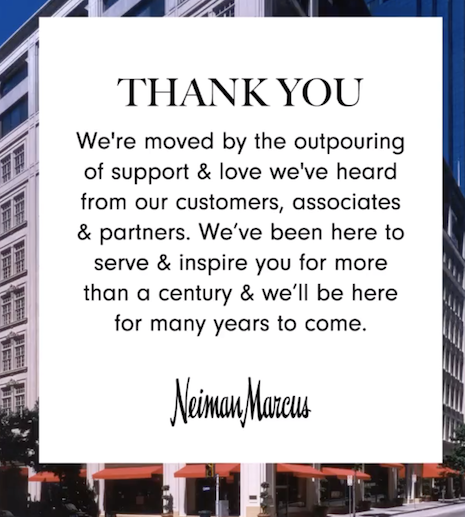- About
- Subscribe Now
- New York,
May 12, 2020

 Nordstrom plans reopen as luxury retailers struggle during shutdowns. Image credit: Nordstrom
Nordstrom plans reopen as luxury retailers struggle during shutdowns. Image credit: Nordstrom
The luxury market is likely to contract 20-35 percent this year, as the COVID-19 pandemic has shut down the world and brought business across luxury sectors to a halt, according to an updated Bain & Company report.
The luxury sector dropped by an estimated 25 percent in the first quarter of 2020, and this slowdown is expected to increase during the second quarter as the United States remains closed for the near future, according to the Bain & Company Luxury Study 2020 Spring Update.
“There will be a recovery for the luxury market, but the industry will be profoundly transformed,” said Claudia D’Arpizio, Milan-based partner at Bain & Company and lead author of the study, in a statement.
“The coronavirus crisis will force the industry to think more creatively and innovate even faster to meet a host of new consumer demands and channel constraints,” she said.
 Claudia D’Arpizio is a Bain & Company partner
Claudia D’Arpizio is a Bain & Company partner
China opens doors
Bain’s new report, done in collaboration with Italian luxury association Fondazione Altagamma, revealed that China will help the sector rebound, despite contractions to the global industry.
Chinese consumers have been crucial supporters of the global luxury industry and are expected to account for almost 50 percent of the market by 2025.
As China has begun to open its stores and shopping malls, these affluent consumers will be a lifeline to struggling luxury brands trying to stay afloat during the global crisis.
Additionally, ecommerce is helping luxury brands stay in business during the pandemic.
Traditional retail and department stores have seen huge drops, as is evidenced by Neiman Marcus filing for bankruptcy.
Purchases of luxury goods online have increased throughout the crisis as affluent consumers are stuck in their homes and looking for ways to entertain and soothe themselves.
After stores reopen, cautious consumers will likely stick with the online channel, which Bain anticipates will represent up to 30 percent of the luxury market by 2025.
 Neiman Marcus post on Instagram thanking customers for their support as the company files for bankruptcy. image credit: Neiman Marcus
Neiman Marcus post on Instagram thanking customers for their support as the company files for bankruptcy. image credit: Neiman Marcus
Luxury sales in Japan and the rest of Asia declined this year, though slightly slower than in other regions and the global mood is subdued.
The collapse of tourism hurt the luxury business, which had started off the year on a high note across the globe. Europe was hit particularly hard in the travel sector, as consumers stopped visiting and shopping.
In fact, travel retail has been annihilated by global air travel grinding to a halt, per the report.
“As consumers slowly emerge from lockdowns, the way they see the world will have changed and luxury brands will need to adapt,” said Federica Levato, Milan-based Bain & Company partner and co-author of the report, in a statement.
“Safety in store will be mandatory, paired with the magic of the luxury experience: creative ways to attract customers to store, or to get the product to the customer, will make the difference,” she said.
All categories have seen declines, with accessories showing the most resilience, and watches declining the most due to a lack of online sales platforms to offset the shutdown of physical channels.
 Federica Levato is a Bain & Company partner
Federica Levato is a Bain & Company partner
Cautiously optimistic outlook
It will take several years for the market to recover to 2019 levels, according to Bain’s report. This might not happen until 2022 or 2023.
But the market should pick up after that and will continue to grow slowly in the following years.
Bain estimates the luxury sector will be worth $346-$357 billion by 2025.
“The speed of future market growth will depend on luxury players’ strategic responses to the current crisis and their ability to transform the industry on behalf of the customer,” Ms. Levato said.
By 2025, Chinese consumers will become the most important luxury buyers and make up almost half of all global luxury purchases.
Mainland China will account for 28 percent of the luxury market in 2025, up from 11 percent in 2019.
Digital will remain significant in luxury’s growth over the next few years.
The online channel has already grown double-digits in 2019 and will continue to gain share as it matures. It will make up 30 percent of sales by 2025.
Affluent Gen Y and Gen Z will become the biggest consumers of luxury goods and drive this digital acceleration.
As luxury brands emerge from the global health crisis, they will need to reimagine the future of their businesses in everything, from their digital storefronts and marketing to distribution and supply chains, to succeed in the new world order.
“Winning brands will be the ones that best interpret the zeitgeist all while remaining consistent with their inner DNA and individual story,” Ms. D’Arpizio said.
Share your thoughts. Click here